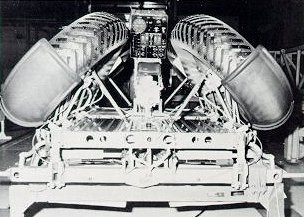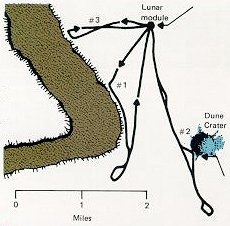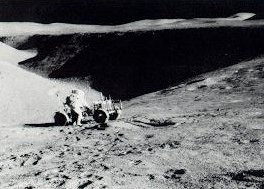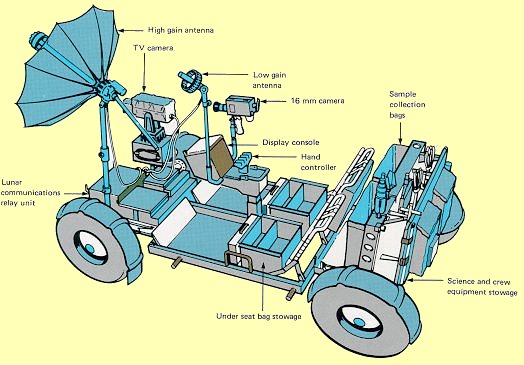Apollo Expeditions to the Moon
TOURING THE MOON
Encumbered by a spacesuit, an astronaut on foot could
not venture very far from the LM; carrying tools and
samples made his forays more difficult. On the last
three lunar missions a lightweight electric car greatly increased
the productivity of the scientific traverses. Mission
rules restricted us from going more than 6 miles from the
LM - the distance we could walk back in a pinch - but even
so the area that could be investigated was ten times
greater than before. The Rover's mobility was quite high;
it could climb and descend slopes above 25°. Crossing a
steep slope was uneasy for the man on the downhill side,
but there were no rollovers. On the level we averaged
close to our top speed of 7 mph. Once, going down the
Lee-Lincoln scarp, we set an informal lunar speed record
for four-wheeled vehicles of 11 mph.

|
Folded up to fit within its storage bay in the LM descent stage,
the little car was designed so that it almost assembled itself.
|
| |
Deploying the Lunar Rover
Carried to the Moon in a nose-down, floorpan-out position,
the Rover could be deployed by an Astronaut paying
out two nylon tapes. In the first stage the car swings
out from its storage bay. Then the rear part of the chassis
unfolds and locks, and the rear wheels unfold. In the third
stage the front chassis and wheels snap out.
Finally, the astronaut lowers it to the surface, and
unfolds the seats and footrests. Torsion-bar springs and latches
mode assembly semiautomatic. Power for the Rover came
from two 36-volt silver-zinc batteries driving an
independent 1/4-hp motor in each wheel. A navigation
system kept track of the bearing and range to the LM.
|

|
Three Expeditions Along Hadley Rille
|

|
Parked by Hadley Rille in the first of the traverses
shown at left above, the Apollo 15 Rover had already displayed
its workhorse willingness. It weighed 462 pounds (but
only 77 on the Moon), and could carry two suited astronauts,
their gear and cameras, and several hundred pounds of bagged samples.
|
|





